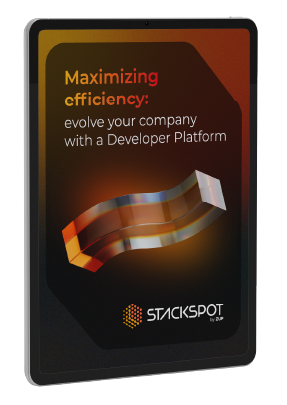Note: This blog post was created by the StackSpot Prompt Engineering team with the support of AI tools. This content underwent rigorous review for technical accuracy, content relevance, and well-written quality before its publication. Enjoy the read!
If you’re a tech aficionado, you know that understanding the nuances and differences between technologies is akin to understanding the subtle complexities of a symphony. In this article, we’ll be comparing Developer Platforms and traditional approaches. Hopefully, we’ll have a new appreciation for both by the end.
In this article, we’ll learn more about each approach and consider how to choose between them.
Traditional Approaches: the time-tested veterans
This method involves developers setting up environments manually or using basic scripting. It’s the equivalent of classic rock – it’s been around forever, and everyone knows how to dance to its tune.
Traditional approaches give developers maximum control over the infrastructure, allowing for customization often impossible with developer platforms. Plus, these methods have been tested and refined over many years. It’s not uncommon for a developer to have a personal library of scripts ready to tackle any task.
Yet, like any classic, there are downsides. Traditional approaches often lead to “environment drift,” where minor inconsistencies snowball into significant issues.
Manual setups can also be time-consuming, and according to the State of DevOps Report 2020, 21% of developers’ time is wasted on maintaining and debugging environments. That’s like playing the same tune repeatedly, isn’t it?
The shift in development environments
To truly understand this shift, we first must understand the walls that traditional development environments have built over the years. For decades, these environments have served us well. They provided a contained space for code creation, testing, and debugging, leading to the release of some truly remarkable software.
However, they were not without their limitations. The configuration was often manual and time-consuming. Scaling up was challenging, and the environments were often siloed, leading to “it works on my machine” scenarios.
Let’s not forget the discrepancies between development, staging, and production environments, frequently leading to unforeseen issues. In short, traditional development environments, while necessary, were far from perfect.
Consume innovation, begin transformation
Subscribe to our newsletter to stay updated on the latest best practices for leveraging technology to drive business impact
The rise of the developer platforms
For those not in the know, a Developer Platform is a self-service portal for developers that automates and abstracts the underlying infrastructure. These platforms take a fundamentally different approach to software development.
They provide a higher level of abstraction, bringing together various tools and technologies under one unified platform. They offer a self-service portal for developers to provision and manage environments, thereby speeding up the development process and reducing the burden on the operations team.
Developer Platforms have become increasingly popular due to their promise of increased developer productivity. According to a report by DORA, high-performing teams using developer platforms deploy 208 times more frequently with seven times lower change failure rates.
The new kid on the block
Developer platforms offer significant advantages over traditional environments. The environments are consistent, eliminating the discrepancies between different stages of the development lifecycle. The process is automated, reducing manual errors, and the entire system is scalable, addressing one of the significant pain points of traditional environments.
But here’s the rub: implementing a developer platform can be complex. It often requires extensive configuration, and even then, there might be scenarios where developers have to move away from the developer platform and perform tasks manually.
Learn about “The power of a development platform” with us; the episode of Stack Insight is available on YouTube; watch the full content:
The flip side
So, there are considerations and challenges that organizations must navigate:
- For starters, setting up a developer platform can be a significant undertaking. Depending on the complexity and needs of the organization, it can be a resource-intensive project.
- There is also the question of change management. Transitioning from a traditional environment to a developer platform can be a significant shift for developers, requiring training and a change in mindset.
- There’s also a risk associated with reliance on a single platform. Any downtime or issues with the developer platform can considerably impact the development process.
- In addition, developer platforms require ongoing maintenance and upgrades, which can add to the operational overhead.
Head-to-head comparison
Here’s where we’ll see the symphony and the rock concert go head-to-head. On the surface, it might seem like a case of “new kid on the block” versus “tried and tested veteran’’. But, as we delve deeper, we find that each approach has pros and cons, a unique cadence that plays well in different circumstances.
- With their automation capabilities, developer platforms can be significant time-savers and productivity boosters. They standardize processes and help eliminate environmental drift. However, they can also restrict flexibility, and setting them up can be complex.
- Traditional approaches, on the other hand, allow for maximum flexibility and customization. However, they are time-consuming and prone to errors, often leading to environmental drift.
The best approach depends on your specific needs and circumstances. It’s akin to choosing the fitting soundtrack for the moment. Do you need the structured symphony of a developer platform, or do you prefer the freewheeling dance of the traditional approach?
Choosing your tune
So, how do you choose between a developer platform and the traditional approach? It’s a bit like choosing between a symphony and a rock concert – it depends on what you value more.
Suppose you focus on boosting developer productivity, standardizing processes, and reducing manual work. In that case, the symphony of a developer platform might be your best bet. But, if you need maximum flexibility and control, you might prefer the dance of the traditional approach.
Remember, the goal is not to choose the “best” method. Instead, it’s about picking the right tool for your needs and circumstances. In the world of software development, there’s rarely a one-size-fits-all solution. So, don’t be afraid to mix and match to create your unique melody.
Future outlook
The rise of Internal Developer Platforms is not just a trend; it’s a manifestation of the broader shift towards DevOps, automation, and cloud-native architecture. As with any significant shift, it poses challenges and opportunities. By understanding these, we can navigate the change more effectively, ensuring that we benefit from the advantages while mitigating the risks.
Remember, the goal is not just about adopting a new technology or platform. It’s about improving the development process, making it more efficient, scalable, and enjoyable for developers. Whether that’s achieved through a traditional environment, a developer platform, or a hybrid approach – that’s the decision each organization needs to make.
Comparing Developer Platforms and traditional approaches: conclusion
In conclusion, developer platforms and traditional approaches have their place in the software development orchestra. They’re different instruments playing different tunes, but they make beautiful music together. Whether you’re a fan of the new-age symphony of developer platforms or the classic rock of traditional approaches, there’s room for both in the concert of software development.
While the rise of developer platforms is challenging the status quo of traditional development environments, it doesn’t necessarily mean the end of the latter. Instead, it’s about rethinking our approach, questioning the traditions, and finding the best way forward. As we continue to navigate this shift, one thing’s for sure – it’s an exciting time to be in software development!
So, keep exploring, keep learning, and above all, keep listening to the music of technology. Because in the end, it’s not about the tool; it’s about the masterpiece you create with it.
Unlock the speed and security of developing with StackSpot!
As experienced software engineers, we understand that you seek to provide efficient and standardized solutions that allow your team to focus on solving business problems, not on assembling the necessary infrastructure to tackle these issues. We recognize that time is precious and efficiency is vital. That’s why we’ve developed StackSpot, our Enterprise Developer Platform designed specifically for professionals like you.
How about a hands-on test of StackSpot, completely adapted to your company’s unique context and challenges? Our goal is to demonstrate how our platform can simplify the distribution of guidelines and make their application easier, saving you time and boosting your team’s productivity.
Book a demo now! We’re eager to get to know you and your challenges. Let’s transform the landscape of your software engineering together with StackSpot.












